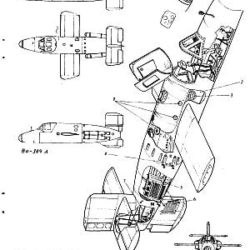Bachem Ba 349 Natter History
The idea which led to this primitive aircraft, known under the name Bachem Ba 349 Natter (Viper), was to produce a vertical take-off, rocket-propelled flying machine, armed with rockets, which could return to earth on a parachute after carrying out an attack. The Ba 349 was based on a truly crude structure, assembled by hand from a large number of wooden parts, but it was fitted out with a large number of sophisticated components which required an intact and highly developed aircraft industry: rocket engine, weapons, governors, instruments, autopilot, oxygen equipment etc. It was the shortage of just these items which prevented a very large number of fighter aircraft being delivered to the Luftwaffe.
The design team at Bachem-Werke GmbH for the Bachem Ba 349 Natter was led by Dipl Ing Erich Bachem, formerly technical director at Fieseler-Werke, and H. Bethbeder, formerly of Dornier-Werke. The resulting designing was to be launched vertically to the vicinity of the bombers, then steered by the pilot who fired the rocket armament and baled out. The aerodynamic shape was as simple as possible to ease production and consisted of a fuselage with stepped cockpit, and rectangular planform stubby wings without dihedral or sweepback and with a symmetrical section and constant profile. Vertical tail surfaces extended above and below the rear fuselage, the upper fin carrying a tailplane similar design to the wing. Rudders and elevators were provided, but there were no ailerons, their effect being catered for by differential operation of the elevators. In September 1944 this design was wind-tunnel tested at the DVL in model form up to 500 km/h (310 mph) and pronounced satisfactory, and construction began at Bachem’s Waldsee factory.
The testing of the Bachem Ba 349 Natter was interrupted again and again, because of the lack of preparation and the haste with which the project had been undertaken. The first test flights were unmanned, and on each occasion the launch failed, and the entire machine was lost. Eventually a number of unmanned launches were successfully accomplished although the machines were still lost, since the parachute landing invariably ended in a fire after touch-down. A manned flight ended in a crash and the death of the pilot. Work continued on the Natter until enemy troops arrived, even though the machine had been cancelled by the Armament Staff on 5 January, 1945. The reason behind this are probably to be found deep in the psychosis linked to the imminent end of the war.
The Bachem Ba 349 Natter was the last interceptor fighter project intended for German air defence which actually flew, even though it was never used operationally.
The plans for the Bachem Ba 349 Natter were sold to the Japanese for whom it was of particular interest but they only managed to partially build a few before the end of hostilities. Only a small number of Ba 349s in completed condition was available for removal and examination by the Allies and, of these, only one preserved today, at the Smithsonian Institute in Washington, and this bears the US evaluation number T2-1011.










